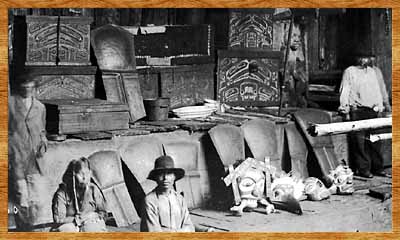
 Clothing Clothing
 Headresses Headresses
 Raven Rattles Raven Rattles
 Copper Shields Copper Shields |
Over time, trade among the people of the north coast groups -- the Haida, Tsimshian, Tlingit and Nisga'a -- led to the mutual adoption of a limited range of objects and materials that symbolized wealth and prestige. These included the regalia used by chiefs, such as headdresses decorated with ermine skins. Other prestigious objects included artistically decorated chests, boxes and bowls used to store and display the food and wealth that characterized the potlatches.
Chiefs of all the tribes of the north coast possessed an array of regalia, which was documented in drawings by the Russian artist Mikhail Tikanov as early as 1818 and which was compared by travellers and missionaries to robes of the Masonic order with regard to their importance in denoting status. For chiefs, this regalia provided a shared frame of reference for the exchange of wealth between nations with different languages and belief systems.
The full set of chiefly regalia consisted of a Chilkat blanket, leggings, an apron, a frontlet and a pair of Raven rattles (or a drum). A chief was also likely to own a shield-shaped plate of native copper; this was a symbol of wealth that was displayed at feasts and could be exchanged or substituted for other commodities. After a chief's death, his coppers were often fastened on his memorial pole.


For nearly two years after his death, the body of Chief Skowl lay in state inside his house at Kasaan, Alaska. The burial chest, draped with a button blanket, is surrounded by storage chests filled with his regalia; beside the burial chest are his eight copper shields. The people in the photo are his slaves, who were displayed as part of his wealth.
Photograph by Albert P. Niblack, 1883 |

The Haida adopted most of these symbols of chiefly rank, particularly the items of clothing, from the Tsimshian and Nisga'a, and either manufactured their own or acquired them through trade with mainland groups. Very few Chilkat blankets appear to have been woven on Haida Gwaii, however; there was no local supply of goat wool, and the pattern boards from which the blankets were woven are missing from collections from Haida Gwaii, although they are common among the Tlingit. The Haida made their own frontlets and Raven rattles, although on occasion they obtained these items in trade from the mainland.
People of classes other than chiefs, such as shaman or members of secret societies, also had their own particular regalia.
|